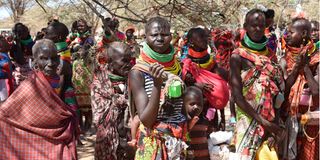Calls for urgent action as maternal malnutrition surges

Locals wait for their rations of relief food distribution by President William Ruto to hunger victims due to prolonged drought, at Nakaalei in Turkana on November 5, 2022.
What you need to know:
- Afghanistan, Burkina Faso, Chad, Ethiopia, Kenya, Mali, Niger, Nigeria, Somalia, South Sudan, Sudan and Yemen represent the epicentre of a global nutrition crisis that has been exacerbated by the war in Ukraine and ongoing drought, conflict, and instability in some countries.
- Since 2020, the number of pregnant and breastfeeding adolescent girls and women suffering from acute malnutrition has increased from 5.5 million to 6.9 million, which represents a 25 per cent increase.
Kenya is among 12 countries where pregnant and breastfeeding adolescent girls and women have been hardest hit by the global food and nutrition crisis, according to a new report released by the United Nations International Children’s Emergency Fund (Unicef).
Afghanistan, Burkina Faso, Chad, Ethiopia, Kenya, Mali, Niger, Nigeria, Somalia, South Sudan, Sudan and Yemen represent the epicentre of a global nutrition crisis that has been exacerbated by the war in Ukraine and ongoing drought, conflict, and instability in some countries.
Since 2020, the number of pregnant and breastfeeding adolescent girls and women suffering from acute malnutrition has increased from 5.5 million to 6.9 million, which represents a 25 per cent increase.
The report titled “Undernourished and Overlooked: A Global Nutrition Crisis in Adolescent Girls and Women” , warns that without urgent action from the international community, the consequences could last for generations to come.
Maternal malnutrition has dire consequences for women and their children. Malnourished women are more likely to die, face complications during pregnancy and childbirth, and have children born too small, too thin and vulnerable to undernutrition, illness and death. According to the report, about half of all stunting in early childhood originates during pregnancy or in the first six months of life. This is a time when children are entirely dependent on their mothers for nutrition.
In Kenya, the Kenya Demographic and Health Survey published last month showed that 18 in every 100 children are stunted, highlighting the challenge of inadequate access to a healthy and balanced diet being faced by many households.
Stunting is defined as low height-for-age and is measured by comparing the height of a child against the international benchmark for a child of the same age. The report also revealed that stunting is higher among children in rural areas at 20 per cent compared to children in urban areas at 12 per cent.
The Unicef report states that more than one billion adolescent girls and women suffer from undernutrition, deficiencies in essential micronutrients, and anaemia, with devastating consequences for their lives and well-being.
Inadequate nutrition during girls’ and women’s lives can lead to weakened immunity, poor cognitive development and an increased risk of life-threatening complications including during pregnancy and childbirth, with dangerous and irreversible consequences for their children’s survival, growth, learning, and future earning capacity.
The report calls for governments, development and humanitarian partners and donors, civil society organisations and development actors to transform food, health and social protection systems for adolescent girls and women. If the situation remains unaddressed, the report warns that the consequences could have severe implications for the health and wellbeing of future generations.





